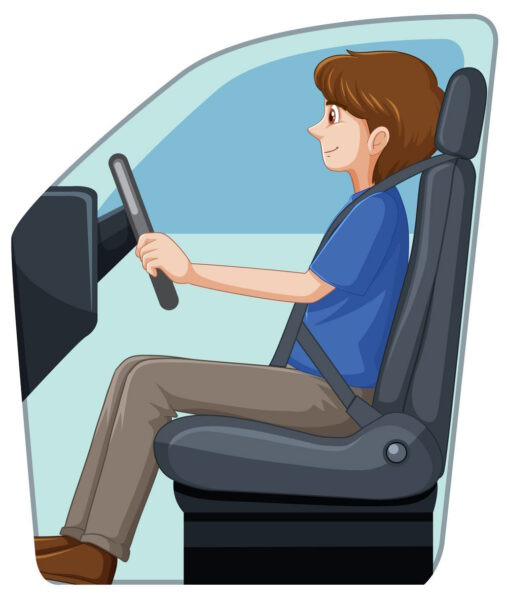Sitting in the same position for a long period of time is a recipe for aches and pains, particularly in your back, hips, neck and shoulders. Setting your seat and steering wheel correctly can help minimise the risk that you’ll exit the car feeling stiff. It’s especially important if you have a long commute (often to a desk job), or you’re travelling long distances as part of your job.
However, even sitting in the perfect position won’t make you completely immune from pain, especially if the seats are not good quality, or the vehicle vibrates.
What tends to be the most common pain drivers experience?
Neck pain – neck craning forwards, sitting in one position and not maintaining mobility (i.e. not looking around enough) contribute to neck stiffness
Hip pain – when the pedals are offset, or if you have something in your back pocket like a wallet or phone, this can throw your hips out of alignment, causing pain. A lengthy period sitting down can tighten the muscles through the front of your hip and down into your thighs, something which can be alleviated by taking frequent breaks and stretching.
Shoulder pain – holding your arms up on the steering wheel, and rounding your back reaching forwards are not good for your shoulders
Upper back pain – your head and shoulders are anchored here, so any pain experienced there can spread through your trapezius muscles. Stretching and strength exercises, plus having the seat in the right position will reduce this.
Lower back pain – sitting for long periods of time weakens the lower back and can inflame it. Pre-existing issues with the lower back can be exacerbated. Use a cushion or adjust the lumbar support in the seat to make it better.
Eye pain or headaches – this usually occurs due to eye strain or fatigue, or dehydration. The cure is usually to rest.
Foot pain – if your shoes are tight and restrict circulation, this will result in pain, as can heavy work boots or those with restricted movement due to the accelerator pedal being balanced for an average foot in an average weight shoe (heavy shoes required you to hold them up to stop them pushing down on the pedal more).
What’s the best position to drive in?

The best seating position is:
- You can reach the steering wheel and rest the heels of your hands on the wheel when your arms are straight
- When you hold the steering wheel your arms are slightly bent (if they are too bent then you are too close to the steering wheel and that could cause you an injury if the air bag deploys – any closer than 30cm to the wheel is bad)
- You can push the brake pedal all the way down to the floor
- When using the accelerator, your leg is bent around 20-30 degrees
- You can rest your left leg somewhere (in some cars, this is difficult because of the transmission tunnel and gearbox configuration [usually American imports])
- The seat squab (the bit you sit on) doesn’t cut into the back of your knees. If it does, use a cushion behind you to shorten the squab; some cars have an adjustable squab.
- The seat back is slightly angled backwards (i.e you’re not upright, but you’re not laid back, either) – somewhere around 100-110 degrees
- The head rest is not pushing your neck forwards – it should be a couple of centimetres behind your head.
- Raise the seat so that you’re not straining to either look over the steering wheel, or under the sun visor. Your eye level should be 8-10cm above the top of the steering wheel.
Once you have everything set up, set your mirrors correctly (see how in this article).
Taking a break after two hours so you can take a walk around your car and do a bit of stretching will improve your outcomes.
Should you use cruise control?
Cruise control enables you to put your right foot in a different position. It can give the muscles in your lower leg and foot a rest.
Should you drive barefoot?
Although the late Denny Hulme used to race barefoot, it can tire your feet out quickly. Driving barefoot is safer than driving in smooth-soled shoes and jandals (especially if the pedals are wet or smooth). It can also be more comfortable if your shoes are tight, or if you are wearing heels.
What can you do if you experience pain when driving?
If you experience pain caused by driving, there are several strategies you can use to help manage the pain:
- Apply heat or ice: Applying heat or ice to the affected area can help reduce inflammation and alleviate pain.
- Take pain medication: Over-the-counter pain medication, such as ibuprofen or acetaminophen, can help manage mild to moderate pain.
- Seek professional help: If the pain is severe or persists despite these measures, consider seeking professional help from a chiropractor, physiotherapist, or other healthcare provider.
- Talk to a personal trainer about strengthening these muscles so that they don’t become inflamed or injured during driving.
Do massage seats work in cars?
Some cars, e.g. Audi RS4, have massage seats. The ones that simply vibrate seem not to have much impact, but if they have rollers which move and actually push into the muscles, these can help reduce tension.

